Table of contents
Almond milk ( almond drink) is a vegan milk alternative, consisting of almonds (seeds of Prunus dulcis ) and water. You can buy it in organic quality ( organic ) or make it yourself, in which case it is raw .
Use in the kitchen
Almond milk has a mild, nutty taste. It can be used in both cold and warm dishes. In Spain and Italy (as latte di mandorla), almond milk has a centuries-old tradition; it is appreciated there as a pure drink or processed into almond sorbet or in warm dishes.
Almond milk is ideal for preparing sweet dishes such as muesli or porridge and easily replaces animal milk in baked goods. With its creamy, nutty taste, the almond drink also refines fresh fruit and vegetable smoothies, coffee or vegan cocoa. In general, it is better to use the unsweetened version, especially for savory dishes such as vegan soups or creamy sauces.
The industry generally produces almond milk or almond drinks from roasted almonds. It is ultra-heat treated to ensure a longer shelf life and is practically never raw. Raw almond milk is easy to make yourself. Other plant-based beverages used in cooking as milk substitutes include: oat milk , rice milk and soy milk .
your
How to make own organic almond milk from natural ingredients is easy to find in our recipe Almond milk as raw food read more.
Vegan recipe for raw berry smoothie with almond milk
Ingredients (for 2 people): 1 ripe banana , 350 graspberries orblueberries , 400 ml almond milk (organic), 100 g fresh spinach .
Preparation: Wash raw spinach and pat dry. Then put all ingredients in a high-performance blender and mix until everything is finely pureed. Enjoy cold and top with fresh fruit such as apple or banana slices.
Vegan recipes with almond milk can be found under the note: " Recipes that have the most of this ingredient ".
| Not only vegans or vegetarians should read this: Vegans often eat unhealthily. Avoidable nutritional mistakes . |
Purchasing - Storage
Within the EU, almond milk can be found under the name almond drink in almost all well-stocked supermarkets such as Coop , Migros , Spar , Rewe , Lidl , Denner , Volg , Billa , Aldi , Hofer , Edeka etc. In organic supermarkets (such as Denn's Biomarkt or Alnatura ) almond milk is also available as an organic product.
In addition to almonds and water, almond drinks often have added salt ( sea salt ). You can buy many different types of almond drinks, including those that contain sugar, flavors, stabilizers and emulsifiers. There is also almond milk that is enriched with vitamins and minerals. If you want to enjoy a raw, natural almond drink without additives, we recommend making it yourself from organic almonds.
The availability of almond milk in the supermarkets mentioned varies depending on the size of the store, catchment area, etc. If you are interested, click on our recorded food prices for the DA-CH countries (above under the ingredient image). There you will find current prices from various supermarkets and their price development.
Storage tips
Do you have to store almond milk in the fridge? Commercially available almond drinks are usually ultra-high temperature treated (UHT) and will last for several months at room temperature if unopened. Once opened, store in the fridge and consume within a few days.
Homemade almond milk can be stored in glass bottles in the refrigerator for 3-4 days.
Before drinking almond milk, you should shake it well so that any suspended matter is evenly distributed.
Ingredients - Nutritional Values - Calories
What does almond milk consist of? The ingredients of an almond drink can vary greatly depending on the manufacturer. Almond milk consists mainly of water, the proportion of almonds varies depending on the product and is often between 2 and 5% (rarely around 7%). Different nutritional values of commercial products can therefore often be traced back to the amount of almonds used.
Homemade almond drink (with an almond content of over 15%) can easily contain over 90 kcal/100g and is richer in healthy ingredients. The raw recipe described in our collection has 3.5 g carbohydrates, 8 g fat and 3.4 g protein per 100 g. The ingredients listed here, however, are based on information from the USDA (US American Nutritional Database) 2 and the ÖNWT 19 and reflect the values of a commercial variant.
With 1.8 mg of vitamin E, 100 g of commercial almond drink covers 15% of the daily requirement of this fat-soluble vitamin. Hazelnut milk or poppy seeds have comparable levels (1.8 mg/100g), while dried mangos (4.4 mg/100g) and dried apricots (4.3 mg/100g) are somewhat richer. Very high levels can be found in hazelnut oil (47 mg/100g) or hemp oil (41 mg/100g). 2
The trace element manganese is present here with 0.03 mg per 100 g and thus covers a very small part of the daily requirement. You can supplement your daily manganese requirement with fruits such as strawberries (0.39 mg/100g) orblueberries (0.34 mg/100g). Dried herbs have a significantly higher value, but wheat germ also contains many times this amount at 13 mg/100g. 2
Since a natural almond drink contains relatively little calcium , there are some calcium-enriched drinks on the market. These contain an average of 330 mg of calcium per 100 g. 1 The variant described here covers 17% of the daily requirement (with 139 mg of calcium per 100 g). Whole almonds contain a good amount of calcium at 269 mg/100 g, while sesame seeds (975 mg/100 g) and chia seeds (631 mg/100 g) exceed these values. 2
The fatty acid ratio between omega-6 and omega-3 (LA:ALA) is extremely unfavorable in almonds (practically no omega-3). Lupins (4.4:1) or oats (22:1) perform better, and you can also use them to make raw oat milk . In our article Vegans often eat unhealthily. Avoidable nutritional errors you will find a table of foods that have a more balanced LA:ALA ratio.
Other almond milk nutrients such as iron , magnesium and vitamin B6 are present in small amounts.
You can find all the ingredients of almond milk, the coverage of the daily requirement and comparison values with other ingredients in our nutrient tables. In the article Nutrients explained you will get a detailed insight into the topic.
Effects on health
How healthy is almond milk? Almond milk is vegan and free of lactose, milk protein and gluten, which is why it is suitable for people with lactose intolerance, cow's milk allergy or soy allergy. Almond drinks do not contain FODMAPs (short-chain carbohydrate compounds such as fructose or lactose), so they are well tolerated by people with a variety of digestive problems. 4
Due to the lower calorie content, almond milk can have a positive effect on the body. In one study, a glass of cow's milk (240 ml with 156 kcal) was replaced by a glass of almond milk (240 ml with 39 kcal) per day and the 30 test subjects who took part achieved a reduction in body weight, BMI and hip and waist circumference over four weeks. 5 You can find more reasons why you should avoid cow's milk in the book review "Milch besser nicht" (It's better not to drink milk) .
Although an almond drink is a good addition to a balanced diet, unprocessed foods such as nuts (e.g. walnuts ) and seeds, raw fruits and natural vegetables contribute much more to a healthy lifestyle: These foods are naturally much richer in fiber, essential fatty acids, vitamins and trace elements.
Dangers - Intolerances - Side effects
People with a nut allergy should also avoid the drinks made from them. In addition to almonds, a nut allergy often also includes walnuts, cashews, hazelnuts, pecans, pistachios or Brazil nuts as triggers. 6 In the case of a birch pollen allergy, cross-reactions can occur after eating certain foods (including almonds). 7 In this case, you can alternatively use nut-free plant drinks such as soy milk or rice milk .
Ecological footprint - animal welfare
Californian almond trees are grown for commercial use mainly in monocultures, which require intensive irrigation due to the dry, hot climate. 9 Almond trees are drought-resistant, but do not produce flowers under water stress. It is therefore important that these plants have a constant water supply. This is particularly difficult to achieve in drought years, as almond producers are very limited in the amount of water available. 10
This is reflected in the ecological footprint of almond milk: In the USA, around 371 liters of water are used to produce 1 liter of almond milk. This is very high compared to oat milk made from local oats (48 liters of water per 1 liter of oat milk) or soy milk (just under 28 liters of water per 1 liter of soy milk). The figures given only refer to fresh water. 12 On the other hand, the water footprint , which includes all water consumption (green, blue and gray water), is much higher. For example, for soy milk it is 296.9 liters of water per liter of soy milk. 13
In terms of the CO 2 footprint and the land required per liter, almond milk performs better than other plant-based milk alternatives in some cases. 12 Source 12 refers to a publication by Poore / Nemecek (2018) for the figures, 11 but we could not find this information there (it is probably additional calculations). Overall, the emissions for all plant-based alternatives, including almond milk (at 0.3 kg CO 2 eq/kg), are significantly lower than the amount generated by the production of cow's milk (1.4 kg CO 2 eq/kg, these figures are collected for Germany). 20
Animal welfare - species protection
In order to achieve good yields, chemical pesticides are used in conventional monocultures of almond tree plantations. This is very problematic for bees, which play an essential role in pollinating the numerous almond blossoms. They absorb the pesticide during pollination, which weakens their immune system and can lead to the death of the bees. To ensure the pollination of the almond trees, beekeepers place bee colonies specifically within the monocultures. The frequent transport and high stocking densities are associated with stress, which has a negative impact on the health of the bees. 9
Worldwide occurrence - cultivation
In Europe, Spain and Italy are the largest growing areas for almonds . Imported almonds come mainly from the USA, Australia and Morocco. 8 A large proportion (80%) of the processed almonds come from Californian almond plantations. 9
Almond milk is one of the most popular plant-based alternatives to cow's milk in North America, Europe and Australia. 1
Industrial production
There are various methods for producing plant drinks. Basically, however, it is an aqueous extract. Depending on the flavor or manufacturer, roasted or unroasted almonds are used. 14 For all plant-based milk alternatives, the starting product is mixed with water. Either the raw material is soaked in water and ground wet, or it is ground dry and then mixed with water (mashing). After that, it is important to choose the right temperature for the mixture or almond mass; the duration of the soaking is also important so that the valuable ingredients can dissolve (extraction). 15
Industrial centrifuges are used to separate the liquid from the solids (decanting). The extraction can then be repeated to achieve a better yield. Depending on the raw material, the liquid is homogenized with cooking oil. After this step, other ingredients are added (if necessary), the drink is heated to ultra-high temperatures for better shelf life and bottled. 15
Often the almonds are blanched and peeled before making almond milk, which gives them a lighter color. Some producers add sweeteners, vitamins, emulsifiers (especially lecithin), acidity regulators, stabilizers and flavors. 17
Further information
According to EU Regulation No. 1308/2013 of the European Parliament and of the Council of 17 December 2013, plant-based milk alternatives may not be called "milk" within the EU.
In 2015, media reported on a class action lawsuit against the manufacturers Blue Diamond and Silk Almond Milks (filed in New York, USA) for unfair advertising. The lawsuit complained that their almond milk only contained 2% almonds ( Blue Diamond 's in the USA did not declare any figures), but was advertised as "made from real almonds" and that certain images on packaging were misleading. 18 Blue Diamond was subsequently forced to change its advertising slogans and pay a fine.
Alternative names
Almond milk (almond milk) is referred to in the trade as almond drink. It is also occasionally referred to as almond drink. In English it is called almond milk or almond drink.
Other uses
Almond milk is used not only in cooking but also in cosmetics. Since almonds have an antioxidant effect, 3 they can also be found in the form of almond milk in hand and face creams, body lotions, but also shampoo and soap. For people with acne and skin imperfections, cosmetic products with plant-based milk alternatives such as almond milk are more suitable than products with cow's milk, as the latter stimulates the production of sebum due to the hormone IGF-1 it contains. This oily secretion produced by the skin is responsible for protecting against skin diseases and pathogens, but is also linked to the development of acne or pimples. 16
Bibliography - 19 Sources
| 1. | Vanga SK, Raghavan V. How well do plant based alternatives fare nutritionally compared to cow’s milk? J Food Sci Technol. 2018;55(1):10-20. |
| 2. | USDA US-Amerikanische Nährwertdatenbank. |
| 3. | Alozie YE, Udofia US. Nutritional and Sensory Properties of Almond (Prunus amygdalu [sic, korrekt mit -s] var. dulcis) Seed Milk. World J of Dairy & Food Sciences. 2015; 10(2):117-121. |
| 4. | Fodmaps.de Fodmap allergy list - Diät bei Reizdarm und anderen Verdauungsproblemen. 2018. |
| 5. | Tamimi JZA. Effects of almond milk on body measurements and blood pressure. Food and Nutrition Sciences. 9. Mai 2016;7(6):466–71. |
| 6. | American Academy of Allergy, Asthma & Immunology. Everything You Need to Know about Tree Nut Allergy. 2020. |
| 7. | AAFA Asthma and Allergy Foundation of America: Can birch trees trigger food allergies? 2018. |
| 8. | USDA Foreign Agricultural Service - GAIN Report. Tree Nuts Annual EU-28. 2017: 5-6. |
| 9. | Albert-schweitzer-stiftung.de Zur Ökobilanz von Pflanzenmilch. 2018. |
| 10. | Goldhamer D, Smith T. Single-season drought irrigation strategies influence almond production. California Agriculture. 1. Januar 1995;49(1):19–22. |
| 11. | Poore J, Nemecek T. Reducing Food’s Environmental Impacts through Producers and Consumers. Science 360. 2018; (6392): 987–92. |
| 12. | Ourworldindata.org Dairy vs. plant-based milk: what are the environmental impacts? 2022. |
| 13. | The water footprint of soy milk and soy burger and equivalent animal products. Ecological Indicators. 1. Juli 2012;18:392–402. |
| 14. | Peta-Schweiz.ch Pflanzendrinks: Die 9 besten veganen Alternativen zu Milch. |
| 15. | Flottweg.com Herstellung pflanzlicher Milchalternativen. |
| 16. | Melnik B. Milk consumption: aggravating factor of acne and promoter of chronic diseases of Western societies. Journal der Deutschen Dermatologischen Gesellschaft. April 2009;7(4):364–70. |
| 17. | Pereira Candiani P. Manufacturing Process of Almond Milk. Teesside University (UK). 2019. |
| 18. | Foodnavigator-usa.com Almond Breeze almond milk only contains 2% almonds, claims false advertising lawsuit. 21. Juli 2015. |
| 19. | ÖNWT. Österreichische Nährwerttabelle. |
- Michael Weber, Federal diploma Pharmacist, MSc Infection Biology
- Natalie Sidler, Dr. phil. I
- Sarah Layendecker, BSc Wildlife Management, vor MSc

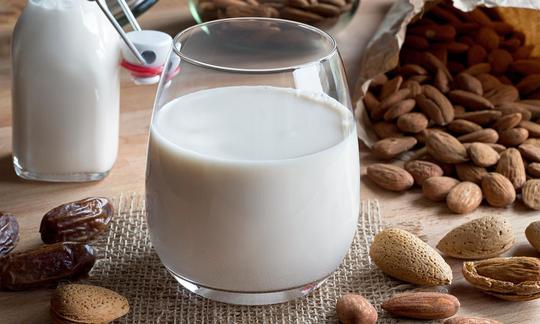





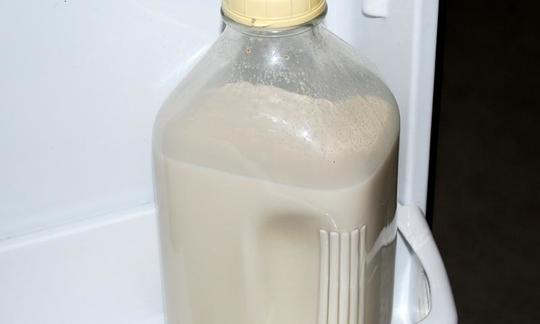


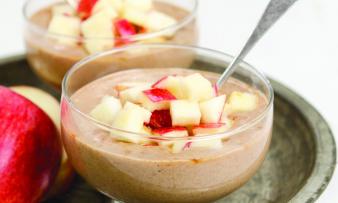
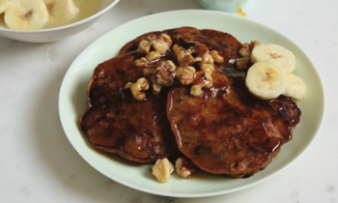

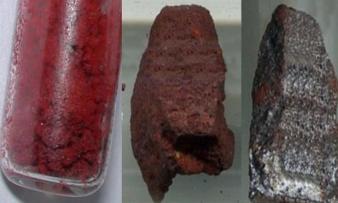



Comments